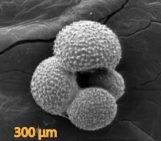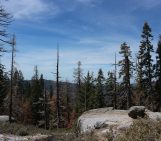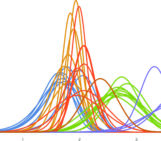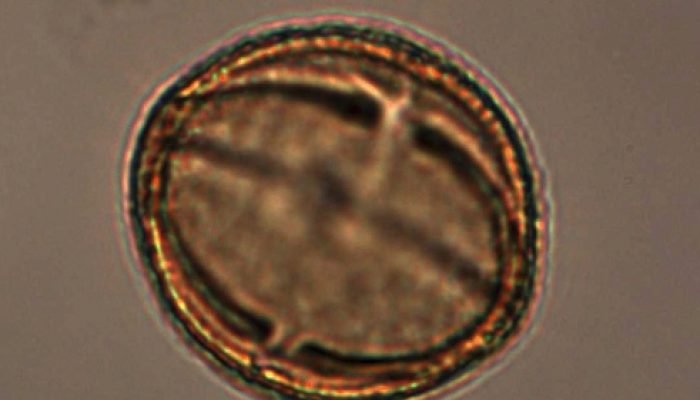
Name of proxy
Sporomorphs (pollen grains and fern spores)
Type of record
Biostratigraphy and Geochronology markers, Vegetation dynamics
Paleoenvironment
Terrestrial environment
Period of time investigated
Present to 360 million years
How does it work?
The sporomorphs (pollen grains and fern spores) are cells produced by plants involved in the reproduction. They are microscopic (less than a fifth of a millimeter) and contain a molecule called sporopollenin in their cell wall, which is very resistant to degradation. The sporopollenin molecule allows sporomorphs to be preserved in sedimentary archives such as lake sediment or peat deposits.
These reproductive structures appeared during the Paleozoic (570 million years ago) but the first spores looked rather similar and were indistinguishable among species. Later speciation of plants promoted the diversification of the reproductive cells between species and brought the opportunity to relate the fossil sporomorphs found in the sedimentary archives to the parental plant that produced them.
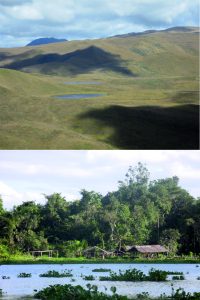
Figure 1. Plant communities are different depending on a wide range of environmental conditions. Above: Andean grasslands (páramo) in Ecuador. Below: Swamp forest in Orinoco Delta (Venezuela).
Plants are immobile organisms, and each species has its own tolerance range to the existing environmental conditions. The occurrence of certain plant communities in a specific environment depends on their different tolerance ranges. For instance, we do not observe today the same plants growing in the tropical rainforests of South America than in the polar tundra (Figure 1). Paleopalynology is the discipline that helps characterizing which plant species have occurred at a specific location during a particular time period. This provides information on the environmental conditions of the studied region. To identify the different species, palynologists have to analyze under the optical microscope the specific features of the sporomorphs’ cell walls. They look at e.g. the presence of spines or air sacs, or the number of apertures that the pollen grain has (Figure 2). These features are specific for each plant, which allows relating the pollen grain found in the sedimentary archive to the plant that produced it at the study location at a particular period of time.

Figure 2. Pollen grains have very different morphologies that allow identification of the plant that produce them. A: Byttneria asterotricha (Sterculiaceae); B: Triplaris americana (Polygonaceae); and C: Calyptranthes nervata (Myrtaceae). Bar scales in the pictures represent 25 micrometers.
What are the key findings made using this proxy?
Paleopalynology has a wide range of applications in geoscience. For instance, the presence of specific sporomorphs has been used as chronological markers to pinpoint several geological periods, especially in the far past biostratigraphy (million years ago) (Salard-Cheboldaeff 1990).
In palaeoecology (the ecology of past ecosystems), the analyses of fossil sporomorphs help in specifying the dynamics of vegetation communities through time. This type of work started a century ago by Lennart van Post (1916) and provided the opportunity to study plants population and community natural trends within the appropriate temporal frame for long-lived species (i.e. tree species such as pines or oaks can live several centuries). Moreover, it provides a unique empirical evidence of the actual responses of vegetation to disturbances that occurred in the past, e.g. natural hazards, human populations land use and other anthropogenic impacts, or climatic shifts.
For instance, regarding past climates, paleopalynology allowed us to:
i) understand the independent behavior of the species during glacial cycles (i.e., when a single species responded to changes, but the plant community as a unity did not respond) in forming new plant communities each time (Davis 1981; Williams and Jackson 2007);
ii) map the re-colonization events and the assemblages formed during the last deglaciation until the vegetation communities we observe today (Giesecke et al. 2017).
In addition, in some characteristic environments, such as mountain regions, the occurrence and disappearance of specific species can allow the estimation of the temperature change with respect to present-day conditions. Another example has been developed in the last decade: the study of organic compounds contained in the sporopollenin of the sporomorphs’ walls. It has been identified as an accurate proxy that registers UV-B rays’ signals (Fraser et al. 2014). As UV-B rays’ are related to solar irradiation trends through time, reconstructing the organic compound variations in the sporomorphs’ walls allows reconstituting past solar irradiation trends in continuous archives such as lake and peat deposits.
This all shows that despite being a tiny structure, pollen grains are the story tellers of how the planet has been changing through history and can provide a wide range of outcomes essential for geosciences.
References
Davis, M.B. (1981). Quaternary history and the stability of forest communities. In: West, D.C., Shugart, H.H., Botkin D.B. (Eds.) Forest succession. New York, NY: Springer-Verlag.
Fraser, W.T., Lomax, B.H., Jardine, P.E., Gosling, W.D., Sephton, M.A. (2014). Pollen and spores as a passive monitor of ultraviolet radiation. Frontiers in Ecology & Evolution 2: 12.
Giesecke, T., Brewer, S., Finsinger, W., Leydet, M., Bradshaw, R.H.W. (2017). Patterns and dynamics of European vegetation change over the last 15,000 years. Journal of Biogeography 44: 1441-1456.
Salard-Cheboldaeff, M. (1990). Interptropical African palynostratigraphy from Cretaceous to late Quaternary times. Journal of African Earth Sciences 11: 1-24.
Von Post, L. (1916). Om skogsträdpollen i sydsvenska torfmosslagerföljder. Geol. Fören. Stockh. Förhandlingar 38, 384–390.
Williams, J.W., Jackson, S.T. (2007). Novel climates, no-analog communities, and ecologica lsurprises. Frontiers in Ecology and the Environment 5: 475-482.
Edited by Célia Sapart and Carole Nehme


